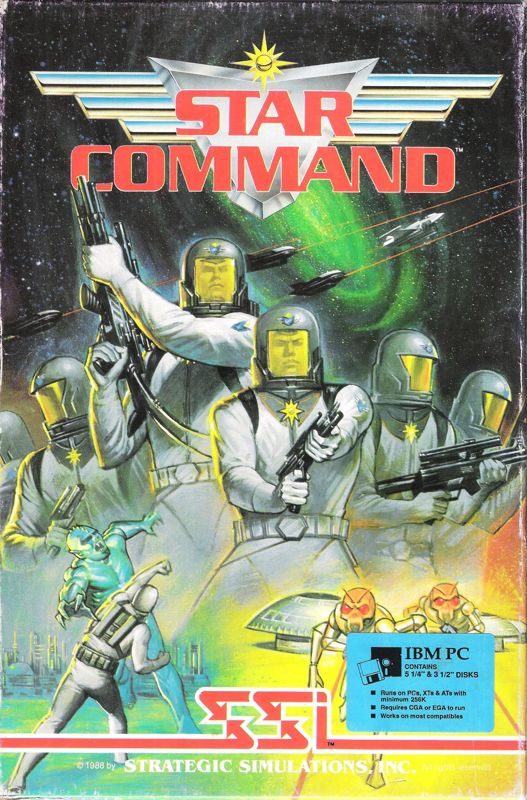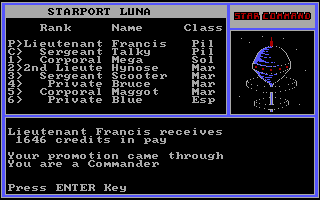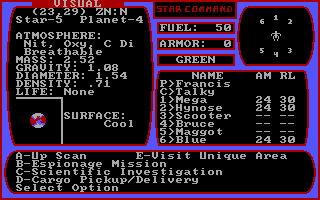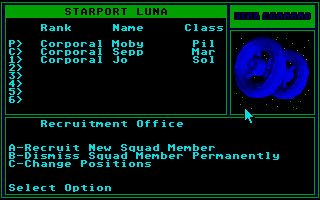Retro Replay Review
Gameplay
Star Command delivers a deep and methodical RPG experience that begins long before you ever depart Startport Luna. Character creation and training are remarkably detailed: each recruit has seven base attributes and a choice of four specialized classes—Pilots, Marines, Soldiers, and Espers. You spend eight simulated years honing skills, toggling between improving raw statistics or learning advanced techniques. This investment pays off in later missions, but patience and strategic foresight are essential.
(HEY YOU!! We hope you enjoy! We try not to run ads. So basically, this is a very expensive hobby running this site. Please consider joining us for updates, forums, and more. Network w/ us to make some cash or friends while retro gaming, and you can win some free retro games for posting. Okay, carry on 👍)
Once your crew is assembled, you must purchase a starship from nine unique hull designs and fit it out with engines, weapons, shields, and support systems. Crew equipment is equally customizable, with dozens of weapons, armor types, and gadgets available for purchase. Balancing your budget between ship upgrades and personal gear creates an engaging economic puzzle that lasts throughout the campaign, especially as money remains tight early on.
Exploration unfolds on multiple scales, from a 32×32-sector galaxy map down to ground-level squad missions. Navigating between sectors and systems involves strategic decisions about fuel management, piracy hotspots under “Blackbeard,” and potential encounters with insectoid aliens or autonomous robotic fleets. When contact occurs, the game shifts to turn-based tactical combat or dialogue-based negotiations, giving you options that extend beyond pure firepower.
Graphics
Although released in the same era as SSI’s Gold Box titles, Star Command’s visuals distinguish themselves with crisp, functional interfaces that clearly convey vital information. The galaxy scan mode displays star clusters and trade lanes in simple, color-coded symbols, while long-range and sector scans reveal enemy vessels, pirate outposts, and friendly starports. This clarity enhances strategic planning, even if the art style feels dated by modern standards.
Ship-to-ship combat and ground engagements both use tile-based maps with small, sprite-based units. While the aesthetic lacks high-resolution detail, each unit is distinct, and terrain features like walls, hazards, and cover are clearly marked. Animations are minimal but serviceable, delivering just enough motion to keep battles feeling dynamic without distracting from tactical depth.
Special sequences—docking at starports, planetary landings, and underground exploration—include thematic visual flourishes such as brief cutscenes or unique map overlays. These touches create an atmospheric bridge between gameplay modes and reinforce the sense of a living universe. Though simple, the graphics consistently support immersion and provide the essential visual feedback required for complex RPG mechanics.
Story
Star Command’s narrative unfolds in a future where Earth is long gone and humanity clings to survival within a triangular sector of space. The political landscape is tense: pirate lords threaten the Alpha border, insectoid aliens stalk the Beta frontier, and unknown robotic entities lurk beyond the third boundary. This layered backdrop offers both urgency and variety, driving you to balance diplomatic maneuvers with military might.
Individual missions range from reconnaissance and convoy escort to sabotage and direct assault. Optional side tasks—trading contraband, rescuing stranded vessels, or negotiating for information—add organic depth to the storyline. Rather than following a strictly linear path, you choose which crises to prioritize, shaping the fate of Star Command and the remnants of human civilization.
Randomly generated elements, such as procedurally placed pirate outposts or variable mission objectives, ensure that no two playthroughs unfold identically. At the same time, a core narrative arc involving escalating threats and shifting alliances keeps you engaged from initial training sessions on Luna to climactic encounters in uncharted space. Character aging, rank advancement, and even the option to clone fallen heroes further weave personal stories into the grand conflict.
Overall Experience
Star Command stands out as a richly detailed RPG that rewards long-term planning and adaptability. Its blend of strategic space navigation, squad-level tactics, and nuanced diplomacy creates a multifaceted experience far beyond a simple shoot-’em-up or dungeon crawl. Fans of classic Gold Box mechanics will feel right at home, yet the sci-fi setting and starship management add fresh dimensions.
The learning curve is steep, particularly during the character creation and training phase, but the game’s pacing allows you to absorb its systems gradually. Economic constraints force tough choices, and the open‐ended mission structure encourages exploration and experimentation. Randomized elements and deep customization options offer high replay value, making Star Command a title you can return to repeatedly.
While its graphics and interface reflect the technological limitations of its era, the core gameplay remains engaging and rewarding. Star Command is best suited for players who enjoy strategic depth, lengthy campaigns, and emergent storytelling in a sci-fi universe. For anyone seeking a challenging tactical RPG with both spaceship and ground combat, this title remains a hidden gem worth exploring.
 Retro Replay Retro Replay gaming reviews, news, emulation, geek stuff and more!
Retro Replay Retro Replay gaming reviews, news, emulation, geek stuff and more!









Reviews
There are no reviews yet.